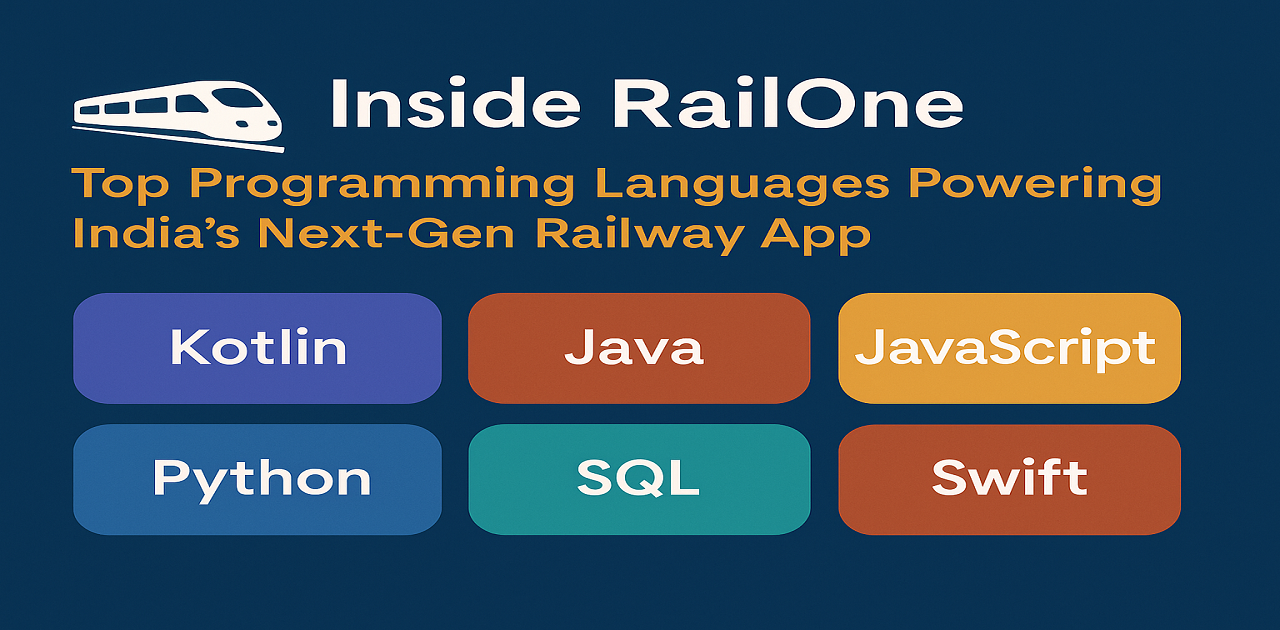Inside RailOne: Top Programming Languages Powering India’s Next-Gen Railway App
In a world where mobility and digital convenience go hand in hand, railway applications like RailOne have become an integral part of modern-day travel. Whether it's booking tickets, checking live train status, PNR updates, seat availability, or train schedules, RailOne offers a comprehensive suite of features for railway passengers across India.
But have you ever wondered what’s going on under the hood of an app like RailOne? What technologies and programming languages power this seamless experience for millions of users?We’ll take a deep dive into the top programming languages used in the RailOne app, their roles in app development, and why these technologies are ideal choices for building large-scale transportation applications like this one.
🔧 Understanding the RailOne App Ecosystem
Before diving into the languages, let’s first understand what RailOne does:
- Live Train Status Tracking
- PNR Status and Prediction
- Seat Availability
- Train Timetable
- Coach Position
- Station Codes and Fare Details
- User-Friendly UI and Offline Access
🔝 Top Programming Languages Behind the RailOne App
1. Kotlin (For Android Development)
With Android being the dominant platform for mobile users in India, RailOne is primarily developed as an Android-first application. Kotlin, being the modern and officially recommended language for Android development, is likely a core language used in RailOne.
Why Kotlin?
- Null safety reduces runtime crashes.
- Concise syntax for faster development.
- Interoperability with Java, enabling legacy code reuse.
- Seamless integration with Android Jetpack components.
Kotlin powers the entire user interface (UI), manages user sessions, and handles user interactions efficiently. It also enables the integration of device sensors and offline caching—a major plus for users traveling through areas with weak internet connectivity.
2. Java (Legacy Support and Backend Services)
Despite Kotlin's popularity, Java remains foundational in the Android ecosystem. Many legacy components and backend APIs in RailOne could still be written in Java, especially those developed before Kotlin gained widespread adoption.
Why Java?
- Robust library ecosystem.
- Excellent performance and multithreading support.
- A massive developer community.
- Ideal for writing backend services and REST APIs.
- Maintaining older modules in the codebase.
- Backend microservices written in Spring Boot or Java EE.
- Security protocols for authentication and encryption.
Even though RailOne is predominantly a mobile application, it also offers web-based services and likely uses JavaScript for the client-side interface on the web platform.
Why JavaScript?
- Core language for web development.
- Works seamlessly with React, Angular, or Vue.
- Enables asynchronous data fetches using AJAX.
- Provides dynamic and responsive UI.
- Building the web dashboard for railway status.
- Managing admin panels and real-time data visualization.
- Integrating Google Maps API and live train movement updates.
RailOne provides smart predictions like PNR confirmation probability, seat availability trends, and train delay predictions—functions that typically require backend machine learning models.
Why Python?
- Rich libraries like NumPy, Pandas, Scikit-learn, and TensorFlow.
- Ideal for data preprocessing, modeling, and deployment.
- Easy integration with web services via Flask or FastAPI.
- Rapid prototyping for ML solutions.
- PNR prediction engine using historical data.
- Delay prediction based on weather, historical delays, or maintenance records.
- User behavior analysis for personalized recommendations.
Data is the core of RailOne. The app needs to manage user profiles, train schedules, station details, and PNR records, which are stored in relational databases.
Why SQL?
- Powerful for structured data management.
- Optimized query performance for large datasets.
- Strong relational capabilities ideal for travel-related applications.
- Storing static data like train schedules and routes.
- Managing transactional data like bookings or ticket statuses.
- Performing quick queries for live status and fare details.
While Android dominates in India, the RailOne app is also available on iOS. Swift is Apple's official language for iOS app development.
Why Swift?
- Modern syntax and faster than Objective-C.
- Great for building interactive and fluid UI.
- Integrates well with iOS native features.
- Creating the iPhone version of the app.
- Ensuring cross-platform consistency in UI and performance.
- Leveraging iOS capabilities like push notifications and Face ID login.
There’s a growing trend in Indian apps to use Flutter, a cross-platform UI toolkit by Google. RailOne may use Flutter and Dart for parts of the app that are common across Android and iOS.
Why Dart & Flutter?
- Write once, deploy anywhere (iOS, Android, Web).
- Smooth UI animations with less boilerplate code.
- Fast development with hot reload feature.
- Large widget ecosystem.
- Developing shared UI components across platforms.
- Faster iteration on beta features.
- Uniform design language on both Android and iOS.
In addition to these core languages, RailOne also utilizes:
- RESTful APIs to communicate with Indian Railways servers.
- Firebase or AWS Amplify for push notifications, analytics, and crash reporting.
- Google Maps API for station and live train tracking.
- Retrofit or Volley for networking in Android.
Apps like RailOne are great examples of how modern transportation systems can be enhanced through smart programming choices. From responsive interfaces to real-time prediction models, the app leverages a diverse set of technologies and programming languages, each playing a vital role in making travel smoother for millions of users.
Comments
Post a Comment